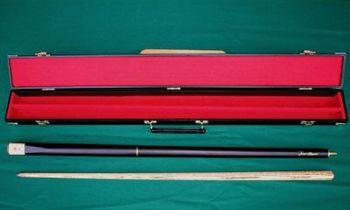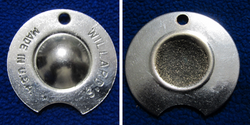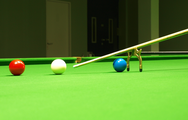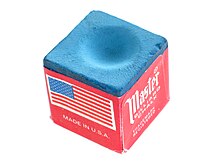Cue (billiards)
As queue [ ko ] (Article:. Dt the or the ., Austrian only the ; French. La queue , "the long, front slightly rounded game Stock at pool"), the game Stock denoted by the balls in billiards are encountered. From the middle of the 18th century, cues became popular instead of the curved rackets that had been common up until then.
history

Since the game of billiards developed from Paille-Maille and croquet , it is a lawn game brought to the table, so the cues looked similar to lawn games in the early days, namely hammer-shaped. From this form, the mace , which turned out to be not particularly useful, the cue was further developed over the course of time in order to achieve a more targeted path of the balls. At this point the ball movement changed from hitting to pushing the balls. The T-like construction was modified from the previous hammer shape so that the end piece was no longer attached transversely to the handle, but axially in the longitudinal direction on the now slightly curved handle. The end facing the ball was adapted to the ball radius, i.e. slightly concave. This allowed the balls to be pushed more precisely. However, it was then found that it was still not possible to achieve the desired or required impact strength or accuracy. In the case of stronger impacts one touched the ball with one of the outer ends of the thickening, but it mostly did not run in the desired direction. Therefore the front piece was removed and the handle developed as a straight, unbent variant. At that time the cue did not have a bitter orange (leather) on the tip . This was only invented in 1807 by the French François Mingaud , who was just serving a sentence in prison. It was now possible to play the balls with spin . Due to his further development and research in this area, he received the title of Professeur de Billard .
properties
The cue consists either of wood or of plastic or aluminum reinforced with glass or carbon fibers. The last two designs mentioned are rather unusual and often only come as an inexpensive variant as indoor cues. There are also manufacturers who offer wooden cues with a metal- reinforced core (e.g. Cuetech ).
The types of wood that are used are different, as are the degrees of hardness, which result in different properties. What is better or worse here cannot be said, as each player has to decide for himself individually. The fact is, a softer top flexes more than a hard one. With a soft top, however, it is easier to add spin to the cue ball, as it has longer contact with the ball due to its elasticity. The better a player is, the more likely he is to use a harder blade. The harder wood allows a more precise game because of the lower elasticity, but requires a better impact technique in order to achieve the required effect.
The total weight of the cue is just as important as the leather that is used as the tip ( bitter orange ). Here, too, there are numerous variants that differ in detail. In professional cues, the bitter orange is glued on, which enables better contact compared to a screwed-on bitter orange.
During production, the wooden surface of the cue is finally sealed with varnish. This protection should be sanded off in the upper area before use (which is already happening in the factory) because the sanded wood slides better over the fingers when pushed. Sandpaper as well as sanding and polishing cloth (micro-mesh mm) with grain sizes from 700 to 12,000 can be used to polish the wood in the upper area and to remove superficial dirt. However, some material is removed with each polishing process. Some players therefore prefer to clean the wood with a sponge dampened with water and a cleaning agent. After such a damp cleaning (which is also controversial) the wood must be rubbed firmly with a clean piece of paper, leather or fabric to smooth the wood again and make it slippery. Special care products can be found in the relevant specialist shops. Players who play this sport regularly play themselves with their cue and of course know exactly the properties of their playground equipment. Switching to a new queue is often not easy and takes time.
The different types of billiards sport also require different cues. The queues differ primarily in the different sizes of bitter orange. It is important to weigh the fine game of a smaller bitter orange against the powerful game of a wider bitter orange.
Components
Most queues are not from a piece of wood lathed but consist of several parts. These are explained here using the example of a pool cue.
The top
The upper part passes the impact from the player's swing arm on the lower part to the cue ball. Harder and softer wood in the processing of the upper part result in special playing properties in the game. Harder, multi-layered wood, for example, reproduces a more precise impact, but it is easier to use spin with a softer top.
Some tops are not made from a single piece of wood, but are made up of several layers using a lamination technique . This laminate construction changes the lateral flexibility of the uppermost section of the tip. This change ensures that the white cue ball deviates less strongly from the intended straight basic direction when it is played from the side (spin kick), so that aiming for spin kicks is made easier.
In the meantime, some pool cue manufacturers offer special low-deflection tops (small deviation). Most of these tops share a weight reduction in the first quarter. Some through a hollow bore, others through a carbon core. This weight reduction means that the white cue ball is less distracted from the intended basic direction when it is cut sideways. Another improvement in this property is a conical shaft compared to the parallel shaft.
The bitter orange
The bitter orange is available in single-layer and multi-layer variants, with the multi-layered being considered to be of higher quality. The material of most known bitter oranges is pig leather. The leather tips can be screwed on or, as with high-quality cues, glued on. In a pool cue, such as a leather having a diameter of 12 mm is shown on the right normally to 13, 9 mm and snooker cues to 10 in Karambolagequeues used mm. 11 By rounding off and roughening the bitter orange, it absorbs more chalk and it is possible to use more spin in the joint.
There is also a distinction between soft bitter oranges and hard bitter oranges. The harder this bitter orange, the easier it is to take a hard push. However, the harder the bitter orange becomes, it becomes more and more difficult to execute a push with a lot of spin.
So-called reactors are used to ensure that the chalk is better accepted by the bitter orange. In doing so, they roughen up the new, bumped or compressed and thus smooth leather. The simpler versions are similar to a flat steel plate with a waffle pattern. They are suddenly applied to the bitter orange. A better version is similar to a UFO , so it has a spherical section-shaped bulge in the middle and a hat-like brim on the outside. A layer of diamond dust is applied to the inside to roughen the leather. The brim has a curved cutout for the ideal shape of the bitter orange cross-section, with which the grinding shape of the leather can be checked. Sanding the bitter orange is important because new or chipped, compressed leather reduces the adhesive surface. The second design is used rotating.
The ferrule
The leather tips are attached to this part, which is usually made of plastic (e.g. the ivory- like Elforyn ), ivory or (for snooker cues) brass. The ferrule protects the rest of the cue from cracks and specifically absorbs hard impacts.
The ferrule of break or jump cues differs from that of normal play cues, as these cues have to withstand more impact force , which is why they are usually made of materials with higher strength.
The shaft
The so-called shaft is the main part of the upper part. It is made of wood; high-quality cues are made of well-seasoned and carefully processed maple wood . Some manufacturers use multi-layered and pressed wood for this. There are still differences in the cut. Pool cues have either a conical or a parallel cut. Snooker cues, on the other hand, only have a conical cut. This part of the cue is passed through the player's fingers when it is pushed and must therefore be cleaned regularly to remove dirt from the billiard chalk and the grease on the fingers using certain care and cleaning agents .
The decorative ring
The decorative ring is the lower end of the upper part of the cue and is attached directly to the transition between the visible wood and the screw connection (joint).
The lower part
The player grabs the lower part and creates the swing of the cue. In the case of expensive cues, there are inlays between the joint and the grip tape and between the grip tape and the butt cap (various precious woods and ivory in the example image ) or printed foils in the case of cheaply processed cues . The entire lower part is provided with a protective layer of clear varnish.
The joint
The connecting piece between the upper and lower part is called a joint . It is mostly made of wood, brass , plastic , ivory or polished steel . The thread braces the upper and lower parts so that the impact energy can be passed on via the contact surfaces of the halves.
The connection is designed as a screw thread. The screw on pool cues is usually made of steel or brass - the thread can consist of wood, plastic, steel or brass. The dimensions of the thread are given in inches - e.g. B. than 5/16 × 14 designated thread has an outside diameter of 5 / 16 inch (7.9 mm) at 14 threads per inch. In addition to the continuous screw threads, there are also quick-release designs in which only approx. 3 threads are cut at the foot of the screw, the remaining threadless part of the bolt is simply pushed in.
The forearm
The area between the joint and the grip tape is called the forearm . The design, weight and weight distribution are significantly influenced by inlays made of precious woods or stones in the forearm.
The grip tape
This is where the player grabs the cue most comfortably. Wrapped Irish Linen is often used here to soak up sweat and provide a good feel . But also versions of nylon , leather or over lacquered grip are frequently encountered.
The butt cap
The end piece of the queue has the task of protecting the bottom of the queue. While you can find a weight screw inside here (pool cues complete with upper and lower part usually weigh between 18 and 20 oz.), On the outside of the more expensive branded cues you can usually see the engraved or inlaid brand logo. Finally, a rubber buffer ( bumper ) protects the cue.
technical structure
There are several designs for the base.
In the simplest case, the lower part is made from a solid, continuous piece of wood. This construction is only found in very simple cues - usually the lower part is divided into two or three segments.
In the so-called full splice technique, the lower part consists of two segments that are jagged at the transition point. The prongs interlock flush. The two segments are usually made of different woods so that the connection is clearly visible and at the same time represents part of the optical design.
The construction, which is now more common, divides the lower part into three sections: the butt , grip area and forearm are each made from a single piece of wood. The spikes of the classic full splice cue are often imitated by inlays made of other wood or, in the case of cheap cues, by stickers. Often the three sections of the lower part are drilled out and lined with a solid piece of maple wood. This corrects a balance that has been changed by heavy real wood or reduces excessive weight.
Help queues
With the pool and especially with snooker, it can happen that the ball lies unfavorably and cannot be reached with your own means. In this case, the player uses auxiliary queues, also known casually as grandma . They are available in different versions. The standard auxiliary cue has an X-shaped tip, in the upper corner of which the cue is placed. However, if there are other object balls in front of the cue ball, it is better to use the raised auxiliary cue (Spider, Extended Spider or Swan).
In the carom these queues are never actually used, there is always achievable and playable by the nature of the game, the own queue ball. However, the use of extensions is more common here too.
Queue extensions
Especially with snooker , there are also extensions for the actual game cue, which are screwed on or turned up, and even extended auxiliary cues, as the normal auxiliary cues are not sufficient due to the size of the table . In some cases, the standard auxiliary queue is also placed on the increased auxiliary queue in order to obtain an even higher number of points.
Break and jump queues
In the case of a jump and break cue, the rear part of the lower part can also be unscrewed using a quick-release thread in order to carry out a so-called jump shot (the jump ball jumping over an object ball when playing pool). In their full length, these queues are used to execute the opening burst (break), as this is usually also a very firmly executed burst.
However, there are also special jump and special break cues, which are only used for breaking or only for jumping.
Jump balls are not allowed in some disciplines (e.g. snooker) and the break is not played hard either, so there are no extra cues for breaking and jumping in snooker. This type of impact is also not used in a collision. Skipping the balls is a game tactic that is rarely used due to the inaccuracies and error rates, as it also requires a lot of training. Most of the time, choosing a different game sequence can lead to a better result. In the area of the trick shot or artistique, the jump ball naturally finds a high occurrence.
Use of chalk
The bitter orange is chalked in so that the ball and cue stick to it when it hits. The chalk works like a clutch and thus also enables the spin game. Without chalk, the tip would slip off while playing spin. The chalk should therefore above all have good adhesion.
The psychologically important moment of chalking should also make the game quieter and create distance from the previous impact, which has a positive effect on the rhythm of the game. The player looks at the situation while chalking.
Correct chalking is done by moving the chalk cube horizontally over the bitter orange with short lines and then pulling it down over the flanks while turning the cue. Typical beginners and film mistakes are turning the cue into the chalk cube, whereby only the flanks of the bitter orange are chalked and the top remains without chalk. As the game progresses, this leads to unfavorable slips and an unsafe style of play. Every professional has his own chalk cube at hand when playing, this is perfectly adapted to the bitter orange of his own cue.
The handling of the queue
Errors are often made when handling the queue. For example, the pushing hand should not hold the cue like a bat. The ball should not be played too hard so that it does not fall off the table and bystanders or objects are not hit by the cue. Correctly measured impacts also increase the accuracy of the impact and encourage the fall of a ball that hits the pocket on the flank rather than in the middle. Balls that are played too hard often bounce off the flank and jump out again.
A correct thrust is usually carried out in the following way: the middle, ring and little fingers of the thrusting hand are slightly bent or not curved at all, the cue lies loosely in the fingers, it should be fixed between the index finger and thumb (closed bridge), most of them However, billiards players prefer the so-called open bridge, whereby the index finger is also slightly curved and the thumb is placed on the knuckle of the index finger, the cue can now be guided over this created area. The shock occurs only through a steady pendulum movement of the forearm from back to front and a calm upper arm, whereby the direction of the cue's impact is not changed. Only the tip (bitter orange) determines an accelerated, normal or slowed run of the game ball by the height of the impact. After the impact, the cue is not jerked backwards, rather it follows the direction of impact and is then slowly withdrawn or even left standing.
Web links
Individual evidence
- ↑ Billardmuseum Weingartner.Retrieved on November 8, 2012.













